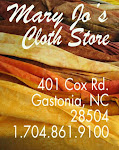At Mary Jo’s
you will find all kinds of trims, trims and more trims! From fringe to banding, braid and decorative
cord, there are many different types of trim to choose from.
This is just one section of the trim area in the home
decorating department. Any decorating
project can use a little trim: draperies, valances, pillows, upholstery and
bedding.
Shopping for the perfect trim can be a little
overwhelming! Here is a look at the most
common types, and a few tips for applying trim. To learn more, visit Mary Jo’s on
February 8, 2014, 10:00 – 11:00 am for a free workshop about trims with Susan
Woodcock. Even more exciting, enjoy 10% off all trims throughout the day!
Tassel
Fringe
Usually constructed of a braid with attached tassels,
this trim is available in solid or mixed color combinations. Tassel fringe can be adorned with crystal,
metal or wood accents. A variety of
methods can be used to apply tassel fringe.
The braid edging can be sewn by hand, machine or applied with hot melt
glue, or fabric glue, letting the tassels hang free. Tassel trim is beautiful on drapery panels,
across the bottom of valances, and on decorator pillows.
 |
| www.milesredd.com |
Bullion
Fringe
This heavy trim is woven with long cords. It comes in a variety of sizes and in solid
or combined colors. Bullion fringe is
most often applied with glues or hand stitching. Look for bullion fringe along
the bottom of sofas, chairs and
ottomans.
Brush
Fringe
This trim is machine sewn in seams of pillows and
cushions for a soft edging. When you
purchase brush fringe it has a chain stitch holding all the threads
together. Leave this stitching in place
until all sewing is finished, and then pull the threads away and fluff up the
fringe.
Bead Trim
Trims with pearl, glass, acrylic, wood and metal beads
are very popular and an alternative to tassels.
Most have a simple tape across the top, which is usually hidden in a
seam, or under edges. Bead trims can be sewn by hand, machine or applied with
hot melt glue, or fabric glue. Use bead
trims on draperies, window valances, or around lampshades.
Gimp Braid
This small braid is so versatile and commonly used because it turn curves
and corners easily, and lays flat without any pleats or puckers. Gimp is used in upholstery to cover tacks and
staples, and is often combined with other trims for creative pillow styles.
Flat Banding
Clean and neat, flat banding has a classic look that can
blend well with contemporary décor.
Flat banding can be solid, or woven with patterns. The Greek Key design, shown in the pillow
above is a current trend. Add flat
banding to draperies, framed around pillow fronts and on duvets and bed
skirts. Flat bandings can be machine
stitched, or glued in place.
Twist
Cord
Decorative cords come in many styles and diameters. The most common is twist cord, which has
individual cords wound together to create one cord, in solid or variegated
colors. Twist cord with an attached lip,
as shown above is machine sewn into the seam of pillows or cushions. You can also find twist cord without a lip,
which is used for tiebacks, formed into decorative knots or as an edging along
interior moldings.
When sewing twist cord around a pillow or cushion, there
is a trick to making a seamless join.
This will be one of the professional techniques Susan Woodcock will
share in her workshop at Mary Jo’s on February 8, 2014, 10:00 – 11:00 am. We hope to see you there!






















































